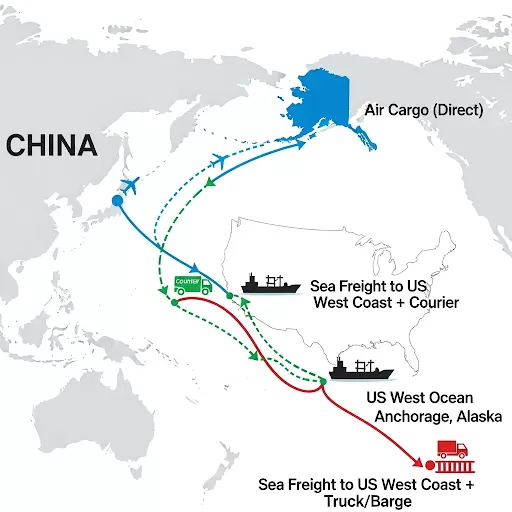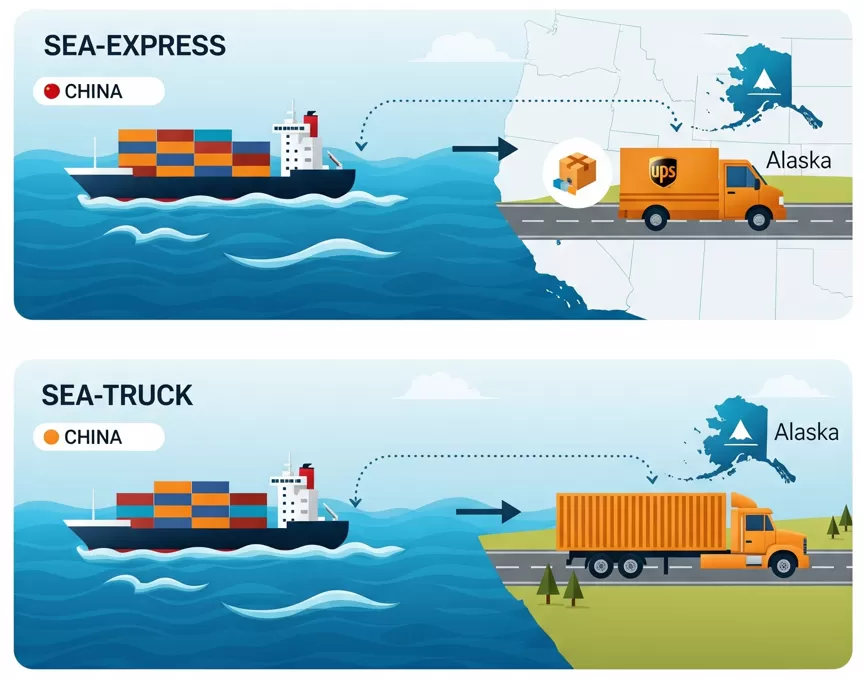Amazon FBA is a pivotal service for e-commerce sellers, and international trade between China and Alaska is growing, driven by small and medium-sized importers, e-commerce sellers, and traditional exporters. Choosing the right shipping method — sea freight, air freight, express courier, or hybrid solutions like sea-truck and sea-express — can save businesses both time and money. This guide explains costs, transit times, customs regulations, and best practices for shipping from China to Alaska in 2025.
Let's begin.
Real-time freight quotes from China to Alaska.
Get Quotes
🔍 Highlights
- Shipping from China to Alaska is available by sea, air, express courier, sea-truck, and sea-express.
- Transit times: Air freight averages 5–10 days, sea freight 20–35 days, sea-express 12–18 days.
- Costs vary: Sea freight is cheapest per CBM, while air freight offers speed at a higher rate.
- Amazon FBA sellers and SMEs often choose sea-express for cost–time balance.
- Customs clearance in Alaska requires proper HS codes, duties, and documentation.
- Cost optimization strategies: consolidate shipments, choose off-peak seasons, use bonded warehouses.
- Insurance & tracking are recommended to protect goods against loss or delay.
Why Ship From China to Alaska?
International trade between China and Alaska is growing, driven by small and medium-sized importers, e-commerce sellers, and traditional exporters. Choosing the right shipping method can save businesses both time and money, ensuring goods arrive safely, on time, and affordably.
🚢 Sea Freight Options
Sea freight remains the most cost-effective way to move large volumes of cargo from China to Alaska.
- FCL (Full Container Load): Best for large shipments.
- LCL (Less than Container Load): Suitable for SMEs with smaller volumes.
- Transit time: 20–35 days (depending on Chinese port and Alaska port).
According to Freightos 2025, sea freight costs are 50–70% lower than air freight but require longer lead times.
✈️ Air Freight Options
Air freight is the fastest way to ship from China to Alaska.
- Transit time: 5–10 days (direct flights shorter, indirect routes longer).
- Best for: High-value, time-sensitive goods.
- Rates: 6–10 USD/kg (IATA 2024 benchmark).
🚛 Amazon FBA China to Alaska: Detailed Guide to Sea-Express (Sea Freight + Courier Delivery) and Sea-Truck (Sea Freight + Truck Delivery)
Key Takeaways First:
- Sea-Express (Sea Freight + UPS/FedEx): 12–18 days, charged by KG, suitable for small-to-medium volume / multiple cartons, ideal for direct delivery to Alaska addresses (e.g., 3PL, retail stores) or FBA routed via U.S. mainland before final delivery.
- Sea-Truck (Sea Freight + Truck): 15–20 days, usually charged per container (FCL) or per cubic meter (LCL), suitable for medium-to-large volumes destined for Alaskan businesses/warehouses, when transit time is flexible.
Special Note on FBA Warehousing:
Amazon rarely assigns Alaska as an inbound FBA location. Most FBA fulfillment centers are in the U.S. mainland (Lower 48). You can:
- Ship via Sea-Express/Sea-Truck to a U.S. mainland FBA (standard FBA inbound process).
- Ship via Sea-Express/Sea-Truck to an Alaskan self-owned/third-party warehouse (3PL), then use MCF/FBM for local fulfillment to Alaskan customers (faster delivery).
1. Positioning and Suitability of Both Methods
✅ Sea-Express (Sea Freight + UPS/FedEx Last Mile)
Best For:
- Amazon FBA sellers, overseas SMEs, cross-border D2C brands.
- Shipments of 100–3,000 kg, multiple cartons, time-sensitive replenishment.
- Direct-to-address delivery (Alaska 3PL, retail stores, project sites), or routing via mainland FBA centers then serving Alaska.
Advantages:
- Lower cost than air freight, faster than traditional sea freight.
- Wide courier coverage, door-to-door (DDU/DDP).
- Ideal for small-volume, high-frequency replenishment.
Considerations:
- Remote area surcharges (Alaska = extended zone; UPS/FedEx apply extra fees).
- Billing by chargeable weight = max(actual weight, volumetric weight). Common formula: volume ÷ 5000 or 6000.
✅ Sea-Truck (Sea Freight + Truck Transport)
Best For:
- FCL shipments, heavy cargo, oversized goods, or consolidated LCL with large total volume.
- Deliveries to Alaskan enterprises, project sites, self-owned warehouses, or 3PLs.
- When slightly longer transit times are acceptable in exchange for lower per-unit cost.
Advantages:
- More economical for large volumes (per container / per CBM).
- Handles oversized/heavy cargo not suited for express couriers.
- Flexible routing via barge/truck (e.g., discharge at Seattle/Tacoma → truck/barge → Anchorage/Fairbanks).
Considerations:
- Arctic weather & road conditions may affect winter transit times.
- Routing options (via Washington → barge or truck) differ in cost and time.
China to Alaska
Amazon fba real-time shipping quotes.
Get Quotes
2. Transit Routes and Timeframes (Reference Planning)
| Method |
Typical Origin |
U.S. Port of Entry |
Last Mile Path |
Reference Transit Time (Door-to-Door) |
| Sea-Express |
Shanghai/Ningbo/Shenzhen → U.S. West Coast (LA/LB/SEA/TAC) |
Seattle/Tacoma/Los Angeles/Long Beach |
UPS/FedEx to Alaska |
12–18 days |
| Sea-Truck |
China major ports → U.S. West Coast |
Seattle/Tacoma |
Truck or barge/ro-ro to Alaska warehouse/project |
15–20 days |
| Pure Air Freight (comparison) |
China airports → Anchorage (ANC) |
Anchorage (ANC) |
Local truck delivery/self-pickup |
5–10 days |
Notes:
- Sea-Express “12–18 days” covers sea leg + customs clearance + courier last mile. Subject to delays during peak season or inspections.
- Sea-Truck “15–20 days” varies depending on route (truck vs barge) and seasonal factors.
- FBA inbound centers are mainly in the Lower 48; Alaska is rarely assigned as an FBA inbound destination.
3. Cost Structure and Quotation Logic
Sea-Express (Charged by KG)
- Chargeable Weight: max(actual weight, volumetric weight). Volumetric = (L×W×H)/5000 or 6000.
- Unit Price Includes: sea freight leg + terminal handling + customs clearance + courier delivery (remote/fuel surcharges included).
- Extras: remote area surcharge, oversize/overweight surcharge, peak season surcharge, inspection/repacking fees, storage.
- DDP vs DAP: DDP includes customs duties/taxes; DAP excludes them (delivered but not duty-paid).
Sea-Truck (Charged by Container / CBM)
- FCL: Ocean freight (20GP/40GP/40HQ) + port charges + truck line-haul + final delivery.
- LCL: W/M (weight or measure, whichever is greater), usually from 1 CBM upward. Add on destination handling + trucking.
- Extras: peak season surcharge, winter surcharge (weather/ice conditions), remote delivery fees, appointment/waiting fees, inspection charges.
Tip: Always confirm whether remote surcharge, appointment fees, customs duties/MPF/HMF, and FBA scheduling are included in the quote.
4. FBA Compliance & Inbound Rules (Applicable to Both Sea-Express & Sea-Truck)
Destination Determination:
- FBA Inbound: As per Amazon-assigned FC (mostly Lower 48).
- Alaska Deliveries: For local stock at Alaska 3PL/self-owned warehouses → then fulfill via MCF/FBM.
Inbound Methods:
- SPD (Small Parcel Delivery): Create shipment → print box labels/FBA labels → often via UPS Partnered. With Sea-Express, UPS is often non-partnered (handled after U.S. entry).
- LTL/FTL: Requires Carrier Central appointment, strict palletization rules.
Carton/Pallet Standards:
- Carton ≤ 50 lb (Team Lift label >50 lb; Mech Lift >100 lb).
- Pallets: 40"x48", 4-way entry, ISPM-15 compliant, max height ≤ 72" incl. pallet. Labels on all sides.
- FNSKU labels on each unit; carton labels scannable.
- Country of origin (Made in China) label required.
Documents:
- Commercial invoice, packing list, bill of lading/airway bill, HS codes.
- Appointment ID (LTL), Shipment ID (SPD).
- Hazmat: MSDS, UN codes, etc.
5. Customs Clearance & Duties (DDP vs DAP)
- IOR (Importer of Record): Amazon does not serve as IOR.
- DDP: Forwarder provides compliant IOR, duties/taxes prepaid.
- DAP: Duties/taxes payable by consignee at destination.
- Tariffs: Based on HS codes. Some Chinese products still subject to Section 301 tariffs. Additional MPF/HMF apply at U.S. ports.
- Regulatory Compliance: FDA (food, cosmetics, medical), FCC (communications), ISPM-15 (wood packaging).
Recommendation: For FBA sellers, DDP is safer (forwarder provides compliant solution, importer designated).
6. Packaging & Labeling – Key to Avoid Rejections
- Carton Strengthening: ≥5-ply cartons, corner protectors, stretch film + strapping.
- Moisture/Cold Protection: Use liners + desiccants (Alaska = extreme cold & humidity shifts).
- Standardized Carton Sizes: Improves stacking & billing efficiency.
- Labeling: Place box labels on flat surfaces, avoid tape seams; pallet labels on all 4 sides.
- Hazmat: Confirm carrier eligibility, declare properly.
7. Typical SOP Workflow
Sea-Express (to U.S. FBA or Alaska address):
- Booking & export customs (China).
- Ocean freight to U.S. West Coast.
- Port clearance → duty/tax/payment.
- Transfer to UPS/FedEx hub → courier waybill generated.
- Last mile delivery (FBA FC / Alaska address).
- Receipt & exception handling.
Sea-Truck (to Alaska warehouses/businesses):
- Booking (FCL/LCL) & export customs.
- Ocean freight → discharge at Seattle/Tacoma.
- Unstuffing/consolidation → truck or barge to Alaska.
- Local truck delivery to warehouse/project.
- Unloading, receipt, POD.
8. Choosing Between Sea-Express vs Sea-Truck
- <3 CBM / <1000 kg / multiple cartons → Sea-Express (cost-effective, to-door).
- ≥8–10 CBM / FCL / heavy or oversized cargo → Sea-Truck (better per-unit cost).
- Urgent replenishment/Q4 peak → Sea-Express.
- Engineering/project cargo → Sea-Truck or customized barge + truck.
- Local fulfillment in Alaska → Sea-Express/Sea-Truck → Alaska 3PL → FBM/MCF.
- Standard FBA inbound → Lower 48 FC is smoother (no need to target Alaska inbound).
9. Risks & Peak Season Strategy
- Peak Season (Sep–Jan): Book space 2–3 weeks early, buffer 3–5 days.
- Remote Fees: UPS/FedEx Alaska surcharges common; confirm in advance.
- Customs Inspection: Ensure consistent HS codes, avoid reclassification.
- Appointment/Delays: Missed LTL appointments may incur rescheduling/waiting fees.
- Insurance: Recommended 110–120% of cargo value (incl. freight). Essential for winter/long-haul.
10. Example Cost Estimates (Not Quotes)
Sea-Express (200 kg, 1.5 CBM, UPS last mile to Alaska):
- Chargeable weight = 1.5×100×100×100 ÷ 6000 ≈ 250 kg (example formula).
- Cost = rate × chargeable weight + remote/fuel surcharge + customs (DDP includes taxes).
- Transit: ~12–18 days.
Sea-Truck (LCL 8 CBM, to Alaska 3PL):
- Ocean LCL (by W/M) + destination handling + truck/barge segment + remote delivery.
- Transit: ~15–20 days.
With packing list (cartons, sizes, weights) + HS codes, forwarders can quote accurately.
11. Required Shipping Packet for Forwarder/Warehouse
- Shipper/Consignee/Notify details (incl. U.S. EIN/IOR).
- Commercial invoice & packing list (CN/EN).
- HS codes, 301 tariff applicability.
- FBA shipment info (SPD/LTL, carton/pallet labels, appointment ID).
- Compliance docs (FDA/FCC/UL/MSDS/battery declaration).
- Insurance application (cargo value, description, qty, POL/POD, mode).
✅ Summary
- Sea-Express = Sea freight leg + UPS/FedEx last mile. Faster & convenient, best for small-to-medium shipments direct to Alaska addresses.
- Sea-Truck = Sea freight leg + truck/barge. More economical for bulk shipments, suited for Alaskan warehouses/businesses.
- FBA inbound usually assigned to mainland FCs (Lower 48).
- For local Alaska fulfillment, route via Alaska 3PL + FBM/MCF.
How much does it cost to Alaska?
Get the latest real-time freight quotes
Get Quotes
💰 Shipping Costs & Transit Times
| Shipping Method |
Average Cost (2025) |
Transit Time |
Best For |
| Sea Freight (FCL/LCL) |
$1,200–$2,000 / container |
20–35 days |
Bulk goods, large importers |
| Air Freight |
$6–10 / kg |
5–10 days |
High-value, urgent cargo |
| Sea-Express |
$3–5 / kg |
12–18 days |
SMEs, Amazon sellers |
| Sea-Truck |
$2,000–$3,500 / container |
15–20 days |
Medium volume, cost-conscious shippers |
| Express Courier (DHL/UPS/FedEx) |
$8–12 / kg |
5–7 days |
Small parcels, urgent shipments |
Data sources: Freightos 2025, DHL, IATA
🛠️ Best Practices for Cost Optimization
- Consolidate small shipments into LCL containers.
- Ship during low season (Feb–April, Sept–Oct).
- Use bonded warehouses to delay duty payments.
- Compare multiple freight forwarders for better rates.
- For SMEs, consider sea-express to balance cost and delivery speed.
🚢 NCL (Non-Container Load) Shipping From China to Alaska
When people say NCL, they usually mean LCL (Less than Container Load), but some freight forwarders also use NCL to describe consolidated sea freight services. This is especially relevant for Amazon FBA shipments and small-to-medium overseas buyers shipping from China to Alaska.
🔑 Key Points:
Definition:
- NCL/LCL means your goods share container space with shipments from other importers.
- Suitable for small-to-medium shipments where booking a full container (FCL) is not cost-effective.
Routes (China → Alaska):
- Sea-Express: China → U.S. West Coast port (Seattle/Los Angeles) → FedEx/UPS to Alaska.
- Sea-Truck: China → U.S. port → Truck freight to Alaska (Anchorage, Fairbanks, etc.).
- Direct Sea Freight: Less frequent, as Alaska is not a major direct port call.
Transit Times:
- Sea-Express (LCL): ~12–18 days.
- Sea-Truck (LCL): ~15–20 days.
- Air Freight (for urgent cargo): ~3–5 days, but much higher cost.
Costs (Estimated 2025 Data – Freightos/DHL/IATA):
- LCL (1 CBM / 200kg): USD $120–$180.
- FCL (20ft container): USD $3,200–$4,000.
- Air Freight: USD $5–7/kg.
Best For:
- Amazon FBA sellers shipping replenishments to Alaska.
- Small-to-medium overseas buyers who need balance between price and speed.
Advantages:
- Cost savings (no need to book full container).
- Flexible for small batches and regular restocking.
- Options for door-to-door with customs clearance.
📦 Insurance & Cargo Tracking
- Insurance: Protects against theft, loss, or damage (usually 0.3–0.6% of cargo value).
- Tracking: Most freight forwarders and couriers offer real-time tracking.
Best practice: Always insure shipments valued over $10,000.
Ready to get started?
Real-time freight quotes from China to Alaska
Get Quotes
❓ FAQ – Shipping From China to Alaska
What is the cheapest way to ship from China to Alaska?
Sea freight (FCL/LCL) is the most economical for large shipments.
How long does sea freight from China to Alaska take?
Typically 20–35 days depending on the port of departure and arrival.
What is sea-express shipping?
A hybrid method: goods shipped by sea to the U.S., then delivered via FedEx/UPS to Alaska.
What is sea-truck shipping?
Cargo is shipped by sea to U.S. mainland ports, then transported to Alaska by truck.
Is air freight faster than express courier?
Express courier (DHL, UPS, FedEx) may be slightly faster for small parcels; air freight is better for larger loads.
Do I need a customs broker in Alaska?
Yes, especially for SMEs unfamiliar with U.S. customs regulations.
What documents are required for customs clearance?
Commercial invoice, packing list, HS codes, bill of lading or airway bill.
Are duties and tariffs different in Alaska compared to mainland U.S.?
Generally aligned with U.S. CBP regulations, but regional handling fees may apply.
Can I ship small parcels from China to Alaska?
Yes, via express courier services like DHL or FedEx.
What is the average cost to ship 1 CBM from China to Alaska?
Around $100–$180 per CBM (sea freight, 2025 average).
Do freight forwarders offer DDP (Delivered Duty Paid) services to Alaska?
Many do, covering customs duties and taxes in the shipping fee.
Should I insure shipments from China to Alaska?
Strongly recommended, especially for high-value or fragile cargo.

 EN
EN
 FR
FR
 ES
ES
 JA
JA
 PT
PT
 RU
RU
 AR
AR






